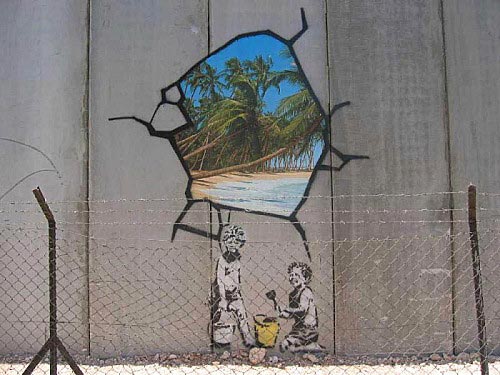
Banksy and Swoon show how street art and graffiti can be used to change reality, and as a radical occult tool for warping the perceptions of the masses
“Graffiti is one of the few tools you have if you have almost nothing. And even if you don’t come up with a picture to cure world poverty you can make someone smile while they’re having a piss.” (Banksy)
Street art is a risky and often illegal way of effectively expressing yourself to the masses without going through the rigmarole of having your work displayed in a gallery or museum.
Banksy and Swoon are two street artists that have plastered and painted their art all over the world, and they do it masterfully.
Banksy created a piece in Bethlehem in 2005 on a concrete barrier, standing three times the height of the Berlin wall, which separates the Palestine occupied territories from Israel.
His work depicts two children wearing swimming trunks and holding buckets and shovels as if they were on the beach. He created an illusion of a hole in the wall looming over the boys; on the other side, we see a white-sanded beach paradise plush with palm trees.
RELATED: William S. Burroughs’ 7 Occult Techniques for Smashing Reality
One year later, in 2006, Swoon made a piece in Bilbao, Spain on the remaining rubble of a torn down building overgrown with plants and surrounded by random debris.
Lurking in the wreckage, we spot two skeleton-faced figures adorned in billowing robes. One grasps a rolled up newspaper above his head, and the other is carrying a fishing pole. They exist on the inside corner of what used to be a house, and it feels as if they belong there.
Banksy and Swoon have each created a piece of art that speaks volumes of how man-made structures can be extremely harmful to people—both in their construction and demolition.
(Below, check out Banksy’s subversion of the opening of The Simpsons to reveal the sweatshop labor that underlies the animation industry.)
Banksy’s beach boys seem to be begging for the massive wall to be torn down so they can enjoy the paradise that is preserved behind it. This was no mistake on Banksy’s part. Through his art, he is making a direct statement about the politics and hate that this wall represents.
When Banksy was working on this piece, an old man approached him and said that his paintings had made the wall look beautiful. Banksy thanked the man, but he responded: “We don’t want it to be beautiful, we hate this wall. Go home.”
Built out of incredible intolerance and bigotry, the only positive effect of the barrier is a slight reduction of attacks. There is no literal utopia behind the barricade, but if differences are settled between the opposing territories and the wall is demolished, it will be a breathtaking event. Paradise can only be achieved through the destruction of this concrete separation that admits hate and judgment.

Contrastingly, Swoon’s skeletons in Spain speak a different story about how buildings negatively affect people. This piece is displayed in an area that had recently housed many hardworking citizens who were removed from their homes so the structures could be destroyed.
Swoon had no idea of the history behind the rubble until she started to hear the whisperings of the locals about her artwork. They told her the image feels like a memorial to a place that no longer exists and the people who no longer live there.
Swoon writes, “These layers of unexpected meaning are one of my favorite reasons for working in the city.”
The skeletons have taken on a completely new significance, one the artist did not intend at the time of creation, unlike Banksy’s obvious political message.
The figures, dead and faded like ghosts, are the only remaining habitants of what used to be home for many. They show us that destroying buildings can be just as harmful as building walls. A community was torn apart to make way for something new that still has not come.
RELATED: Incredible Psychedelic Paintings by a Man With Pineal Cancer
Without walls or buildings, street artists would be without canvases. The relationship that Banksy and Swoon have with their surface is apparent and powerful. They have both targeted areas for their creation that have important history and evoke strong emotion in everyone who is familiar with the structures.
It takes a certain kind of fiery passion to risk being prosecuted, fined, or jailed for your artistic expression. Street artists are often called vandals, but I believe these two artists are respectable vigilantes.
The wall that separates Israel and Palestine will not be torn down solely because Banksy made a visual statement on its surface. However, perhaps he will inspire people to think and dream about a peaceful paradise, a dreamland with no barricades or violence.
Instead of monotonous grey concrete for miles, thanks to Banksy, people can look at playing children and palm trees. Similarly, the Spaniards who used to reside in the homes that are now ruins will never have their neighborhood back.
Nevertheless, Swoon has given them homage, and perhaps a little hope, by immortalizing the evacuees of the buildings that were once treasured homes.
Check out our free guide to chaos magick here. Start learning magick and occultism at Magick.Me, our online school for chaos magick. Start learning magick and occultism at Magick.Me, our online school for chaos magick. Start learning magick and occultism at Magick.Me, our online school for chaos magick.
